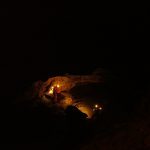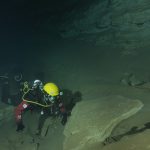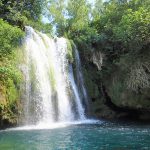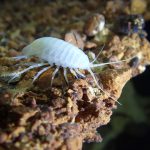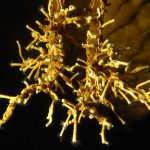The Stara jametina cave
The Stara jametina cave is the deepest speleological structure in Krka National Park.
It is situated at an elevation of 200 metres on the left bank of the Čikola River over Punčka Draga, near the settlement Gornji Krnići by Konjevrate. The cave is overgrown with dense vegetation. It has two entrances that resemble depressions, one is a cave entrance the other a pit entrance. Both lead into the entrance hall.
Though the name (meaning Old Large Pit) implies it is a pit, based on the average slope of the channel and the speleological classification, this structure is actually a cave. It is nearly completely passable, without the need for any speleological techniques, with the exception of a single 4-metre vertical drop.
Stara jametina is a branching speleological structure, explored to a length of 188 metres and a depth of 85 metres. Further exploration is not possible due to the narrow fissures. The cave is characterised by large spaces divided by narrow channels, and it can be naturally divided into four main halls.
Stara jametina was formed within transitional deposits of conglomerates, marly limestones and marl. A hall in eroded marl is found at a depth of 40 metres. This cave has no hydrogeological function, though there is some percolating water. It is ornamented with lovely stalagmites.
The average air temperature throughout the structure is 11.9°C. However, the entrance hall is highly influenced by external weather conditions, and when this hall is excluded, the mean air temperature in the rest of the cave is 12.4°C.
The relative air humidity is 100%, with the exception of the entrance hall where the humidity is also influenced by the external conditions.
The cave fauna inhabiting the Stara jametina cave is very diverse. According to the ecological classification of cave taxa, it is inhabited by troglobionts, troglophiles, subtroglophiles and trogloxenes.
More than 50 taxa have been recorded in the cave, including snails (Gastropoda), spiders (Araneae), pseudoscorpions (Pseudoscorpiones), harvestmen (Opiliones), mites (Acari), isopods (Isopoda), centipedes (Chilopoda), millipedes (Diplopoda), springtails (Collembola), bristletails (Diplura), silverfish (Thysanura), beetles (Coleoptera), booklice (Psocoptera), true flies (Diptera), grasshoppers and crickets (Orthoptera), butterflies and moths (Lepidoptera), earthworms (Lumbricidae), bees, wasps and ants (Hymenoptera) and bats (Chiroptera).
Among these, many taxa are endemic to the Dinarides and to Croatia. The cave is also home to Verhoeffiella margusi, a troglobiont springtail species that is stenoendemic to Krka National Park, meaning it is found nowhere else on Earth.
Since 2018, research on the environmental parameters have been ongoing in the Stara jametina cave. This is the only research of its kind in Croatia, aiming to determine the rate of rock wearing and denudation, and the climatic and palaeoclimatic properties of the karst in Krka National Park.
Photo: Marijana Cukrov



